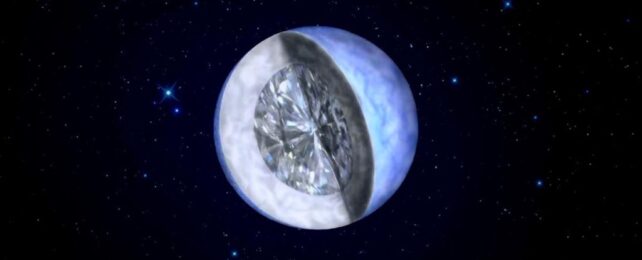
To us, stars may resemble cut jewels, glittering coldly against the velvet darkness of the night sky. And for some of them, that may actually be sort of true.
As a certain type of dead star cools, it gradually hardens and crystallizes. Astronomers have found one doing just that in our cosmic backyard, a white dwarf composed primarily of carbon and metallic oxygen just 104 light-years away, whose temperature-mass profile suggests that the center of the star is transforming into a dense, hard, 'cosmic diamond' made up of crystallized carbon and oxygen.
The discovery is detailed in a paper accepted into the Monthly Notices of the Royal Astronomical Society and available on preprint website arXiv.
"In this work we present the discovery of a new Sirius-like quadruple system at 32 parsecs distance, composed of a crystallizing white dwarf companion to the previously known triple HD 190412," write an international team of astronomers led by Alexander Venner of the University of Southern Queensland in Australia.
"By virtue of its association with these main sequence companions, this is the first crystallizing white dwarf whose total age can be externally constrained, a fact that we make use of by attempting to empirically measure a cooling delay caused by core crystallization in the white dwarf."
All things in the Universe must change. Every star that hangs in the firmament, shining brightly with the light generated by atomic fusion, will one day run out of fuel for their fires and evolve into something new.
For the vast majority of stars – those below about eight times the mass of the Sun, and including the Sun – that something is a white dwarf star.
When the fuel runs out, the star's outer material is shucked into the surrounding space, and the remaining core, no longer supported by the outward pressure supplied by fusion, will collapse down into an ultradense object, around the size of Earth (or the Moon!), but packing in as much mass as 1.4 Suns.
The matter in white dwarf stars is highly compressed, but it's prevented from collapsing further by something called electron degeneracy pressure. No two electrons can occupy identical states, and this keeps the white dwarf from becoming even denser, as seen in a neutron star or black hole.
White dwarf stars are dim, but they still shine with residual heat. Over time, they cool, and are expected to evolve into something called a black dwarf stars when they lose all their heat and become a cold lump of crystallized carbon.
Calculations suggest that this process takes a very long time, about a quadrillion years (that's a million billion years); since the Universe is only about 13.8 billion years old, we don't expect to find one anytime soon.
What we can do is identify the signs of crystallization starting in the cores of the white dwarfs we see around us.
During crystallization, the carbon and oxygen atoms inside the white dwarf stop moving about freely and form bonds, arranging themselves into a crystal lattice. Energy is released during this process, which dissipates in the form of heat.
This produces a sort of plateau or slowing in the cooling of white dwarf stars, which can be observed in the color and brightness of the star, making it appear younger than it actually is.
In order to accurately gauge the brightness of a star, you need to know with precision how far away it is, something that has been made much more possible in recent years due to the high-precision stellar mapping conducted by the Gaia mission.
This means that we can now identify crystallizing white dwarfs with a lot more confidence.
Venner and his colleagues were using the Gaia data to search for multiple star systems, by identifying stars whose association with others may have been unclear.
And they found that a recently discovered white dwarf star (remember these things are very dim) was gravitationally bound up with what had been thought to be a system of three stars, named HD 190412.
The discovery of the white dwarf, now named HD 190412 C, made the triplet a quadruplet, but there was more going on. Its properties suggest that it's undergoing the crystallization process.
Whether or not that white dwarf crystal is diamond is unknown; the density of white dwarfs is over around 1 million kilograms per cubic meter, while the density of diamond is about 3,500 kilograms per cubic meter. Denser allotropes of carbon do exist; on the other hand, there's plenty of diamond floating around out there in space.
The other three stars in the system allowed the team to externally constrain the white dwarf's age – something that hasn't been done before for a known crystallizing white dwarf.
The system's age is around 7.3 billion years. The white dwarf's age appears to be around 4.2 billion years. The discrepancy is 3.1 billion years, suggesting that the crystallization rate has slowed the cooling rate of the white dwarf by approximately 1 billion years, the researchers say.
In and of itself, the dating isn't sufficient to alter our models of white dwarf crystallization, but the discovery and its proximity to Earth suggest that there might be many more such systems out there that we can exploit for benchmarking this fascinating process.
"We propose that the discovery of this system at only 32 parsecs suggests that similar Sirius-like systems containing crystallizing white dwarfs are likely to be numerous. Future discoveries may therefore allow for stronger tests of white dwarf crystallization models," the researchers write.
"We conclude that the discovery of the HD 190412 system has opened up a new avenue for understanding crystallizing white dwarfs."
The research has been accepted into the Monthly Notices of the Royal Astronomical Society, and is available on arXiv.





No comments:
Post a Comment